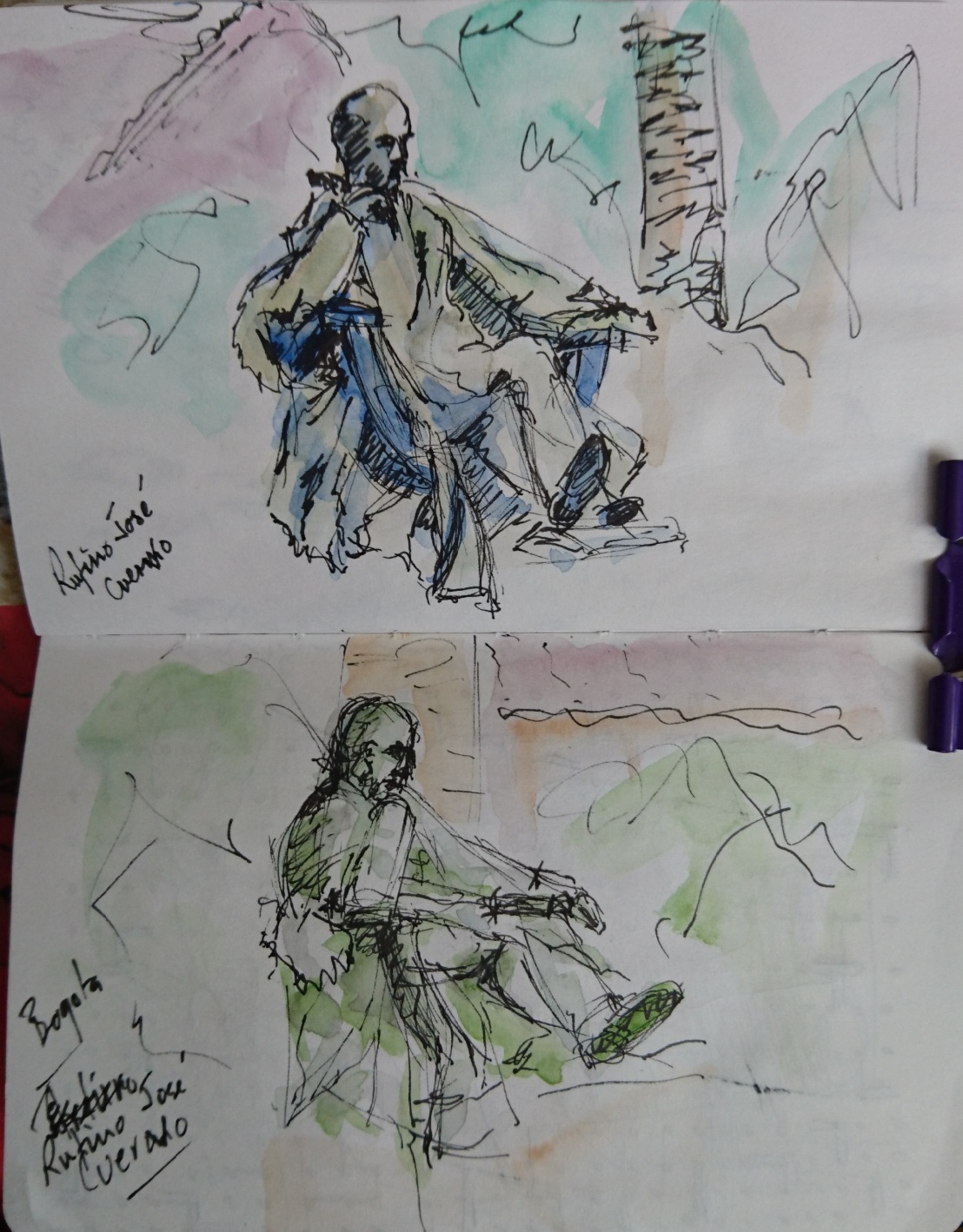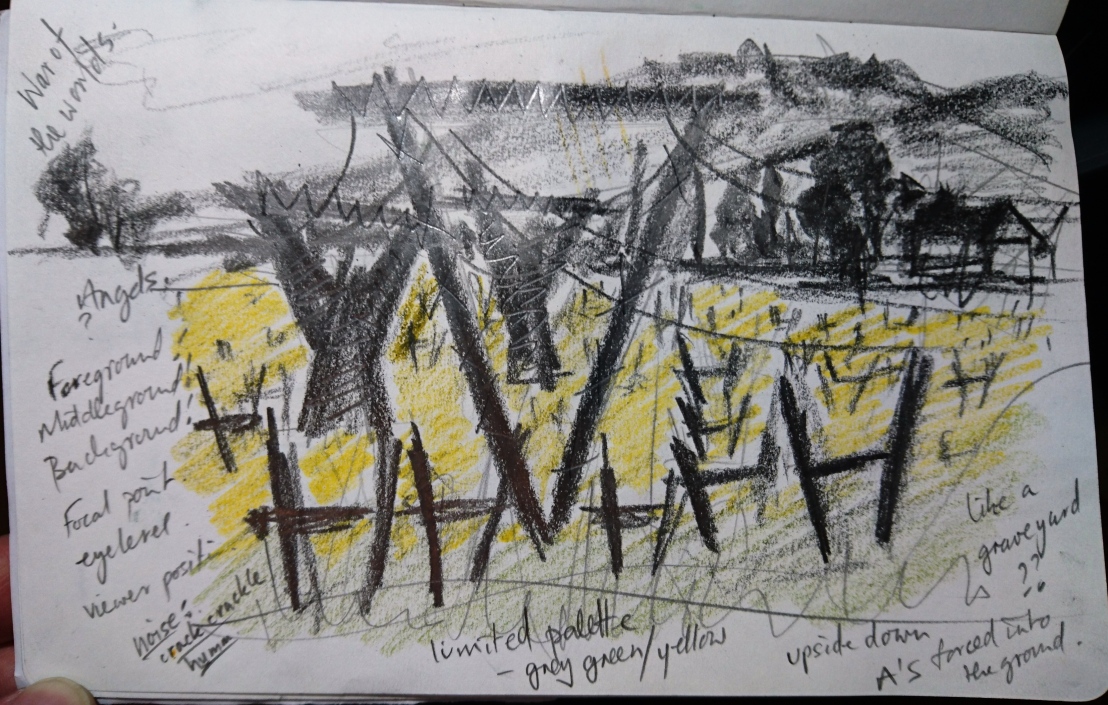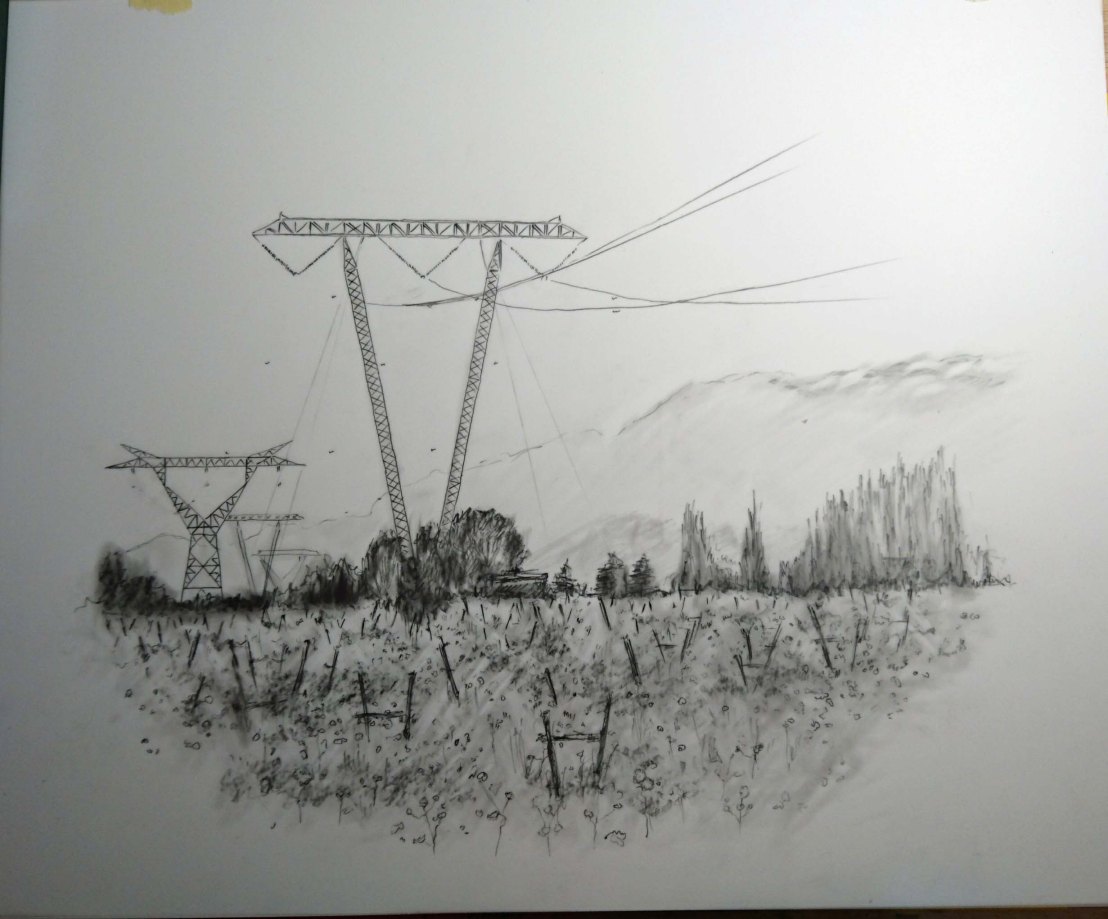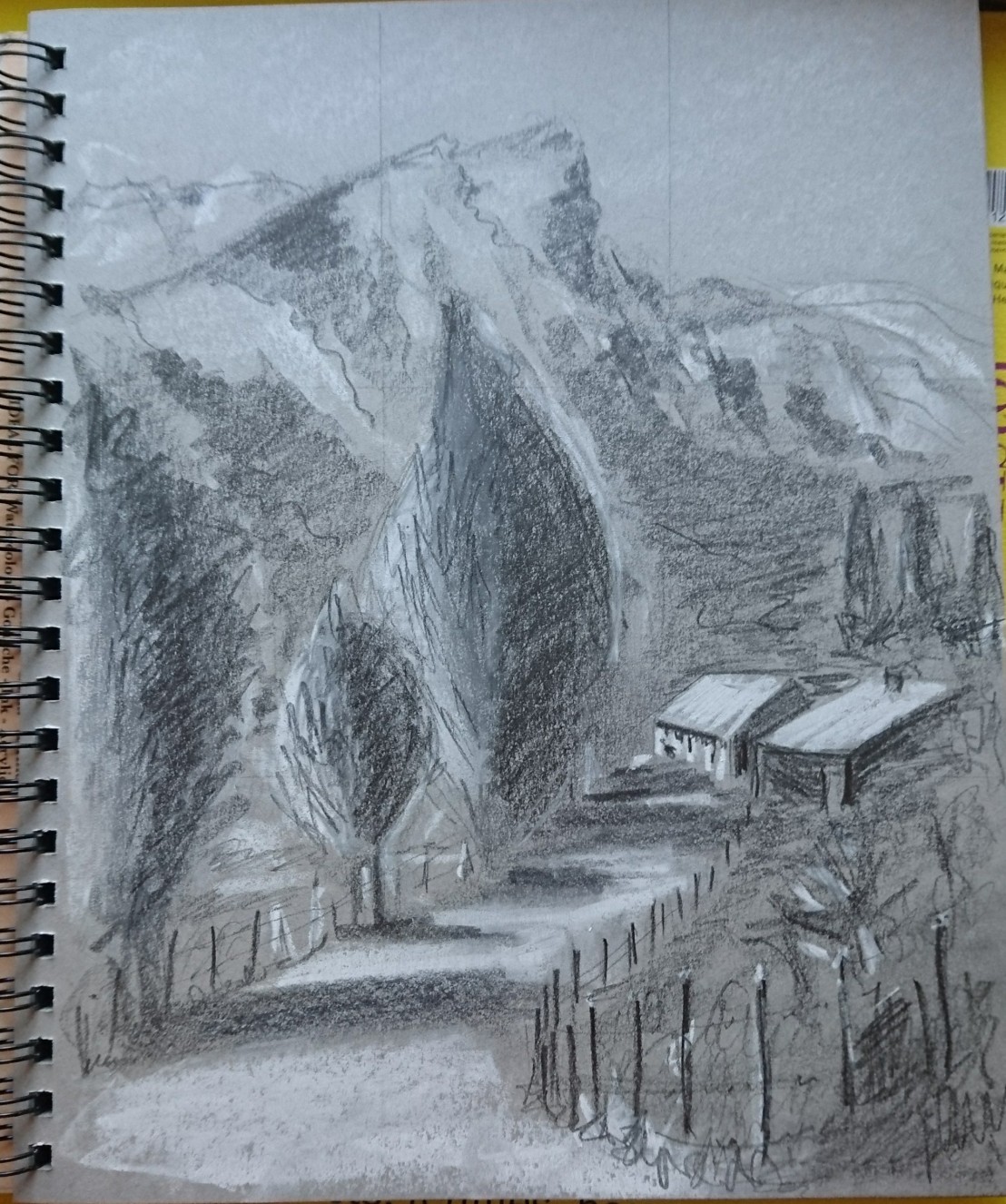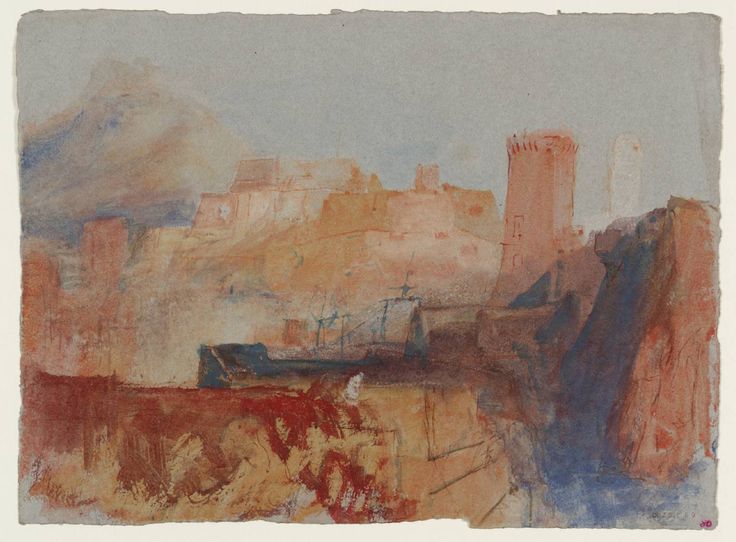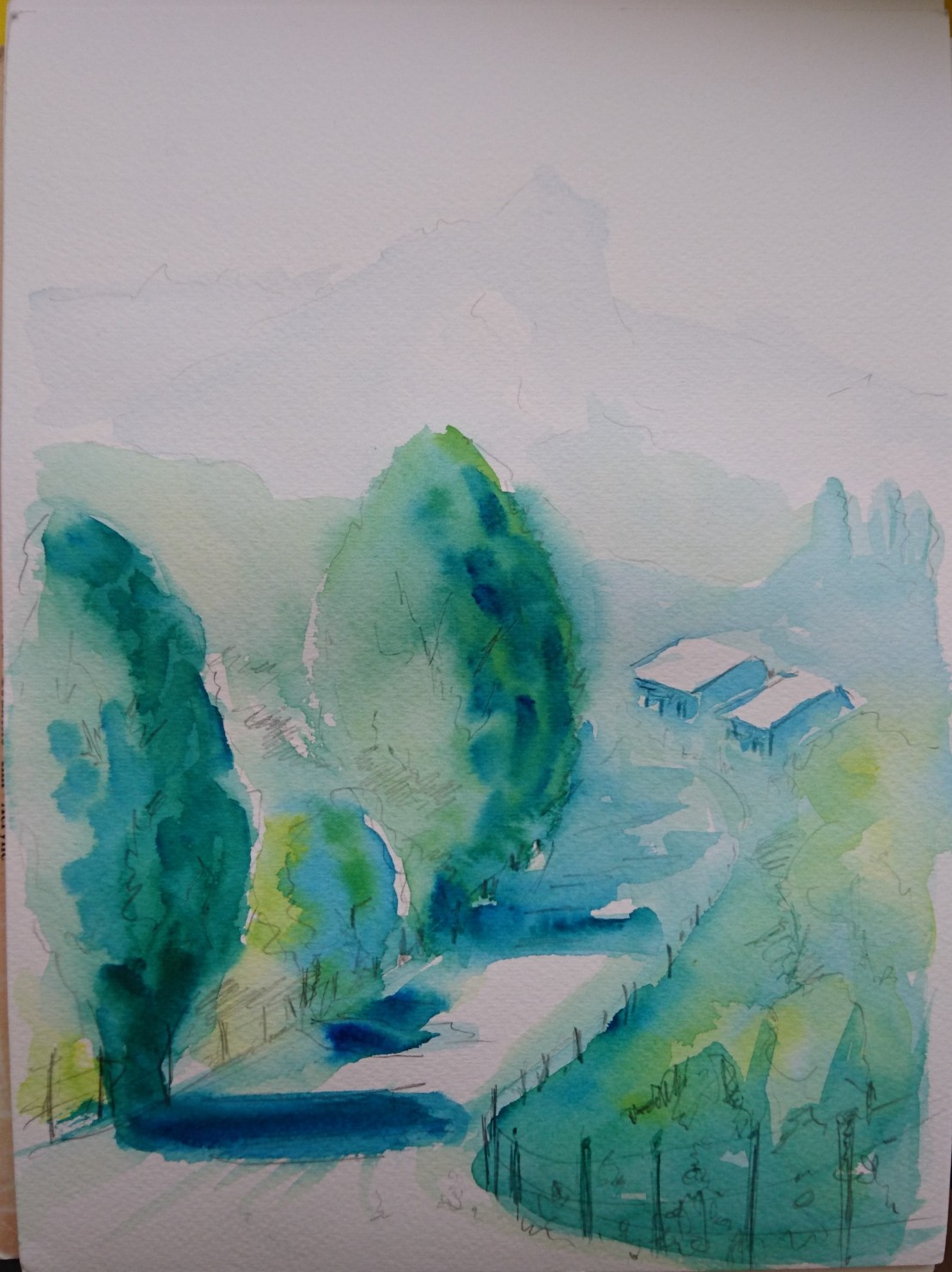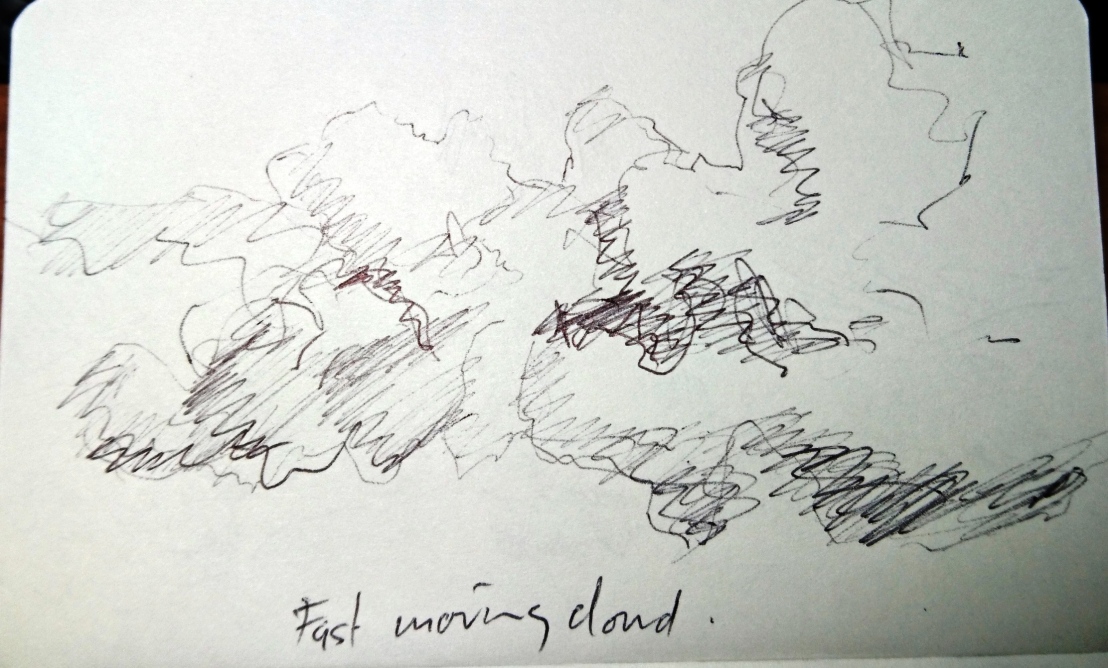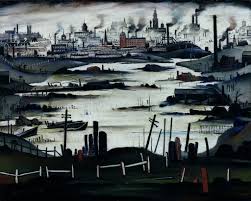Project 5 Townscapes
Research Point – John Virtue and Robert Birmelin
I am very interested in the work of John Virtue – especially his large London works. I particularly like the way he paints a sillouette of the scene and then using marks/textures and the light on the landscape to build up very complex layers of interest – his mark making is very much that of an action painter (Jackson) – dripping, rubbing, spraying – large and small gestures – and his influence of Turner and Constable, painters well represented in the National Gallery Collection. Virtue uses many sketches and works also from his memory of the scenes he paints – reiterating the importance of a sketchbook and sketching – in both tone and line:

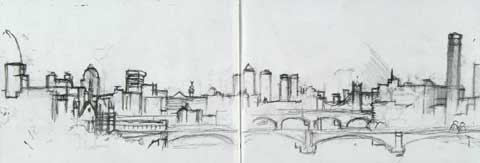

There was another link that interested me – that of his contact and interest in the work of Frank Auerbach who was taught by David Bomberg, an artist that painted scenes of Blitzed london after the war.

I my own drawings below there is evidence of a fight between nature and man – and man’s imposition on the landscape both rural and urban. John Virtues images are more cruel and stark – stripped of what he calls the ‘White noise’ and absent of people – just himself against the landscape and elements.
Another artist of great interest to me is Robert Birmelin who uses the urban environment as his subject matter. I am interested in his use of overlap/transparency to depict not only perspective but movement and the passing of time.
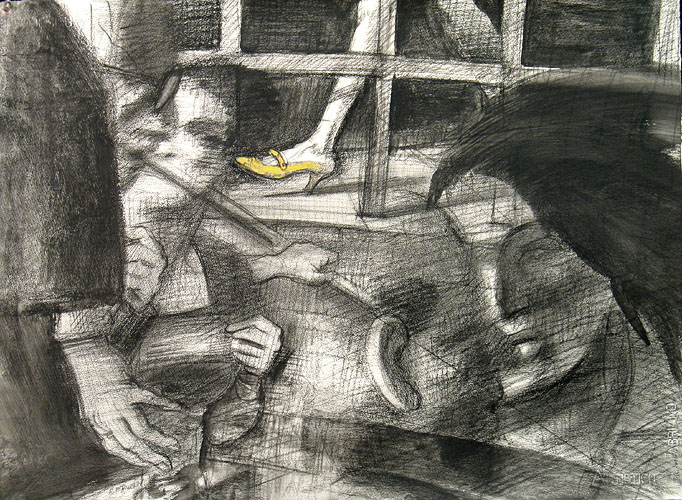
In this example people pass by in the metro, the transparency recording different moments in time. The eye line position strategically placed with the viewer looking across a stairway – in which the subjects are moving past at different heights both near and far adding an extra level of interest.
I intend to find a use for this approach in my urban landscapes and also in Part 4.
Exercise 1 Sketch of townscape drawings
I went out early in the morning to produce these drawings to make use of the shadows produced with the sun low in the sky. I found it difficult to find a comfortable place to sketch and many of the drawings I made were done standing. My favorite place was an abandoned petrol station which I sketched and photographed for future use.
The left hand sketches (not good photographs) were made standing using a 3B pencil within a 10cm square. The RH drawing was a quick sketch in the style of Frank Auerbach. Light was fairly strong and low from the RHS. There were some very clear tones of both white and black – as can be seen in this B&W photo taken from a slightly different angle:

Before leaving the scene, I took many photos at different angles and distances to use later. It was also beginning to get very hot so I also decided to finish sketching for the day outside.
I also made similar drawings of the side of a church in the same street:

I spent more time on these drawings sitting down on the opposite side of the street. At first there was hardly any traffic and the street was quiet and peaceful. As I finished the drawings there were more people about and the traffic started to build up. This is an interesting building but difficult to find a good/safe viewpoint. I included a couple of figures to give a sense of scale to the drawing.
I decided to take the petrol station drawing further. It intrigued me as this is a very busy street and very close is a very large workshop/school for the Copper Mining Industry – the principal industry and the biggest employer in the area. First thing in the morning it is peaceful and quiet and this pertrol station – deserted – is a strange sight among the hussle and bustle. The morning was warm, no breeze, clear blue sky, and ideal for this type of scene – deep shadows and very bright highlights. I wanted to experiment with mylar further and I liked the effect of pencil on mylar – so wanted to try graphite/coloured pencil.
This exercise was more about shapes and shadows etc so my line drawing with the central sign was ok but was only suitable if drawn tighter. I did however try out the effects on mylar:
Both drawings were to loose and drawn very quickly – also the coloured pencil ws muddied by the layers of graphite. In the RH drawing I used a graphite block to fill in rather than pencil and I liked the effect and depth of tone.
Final drawing:
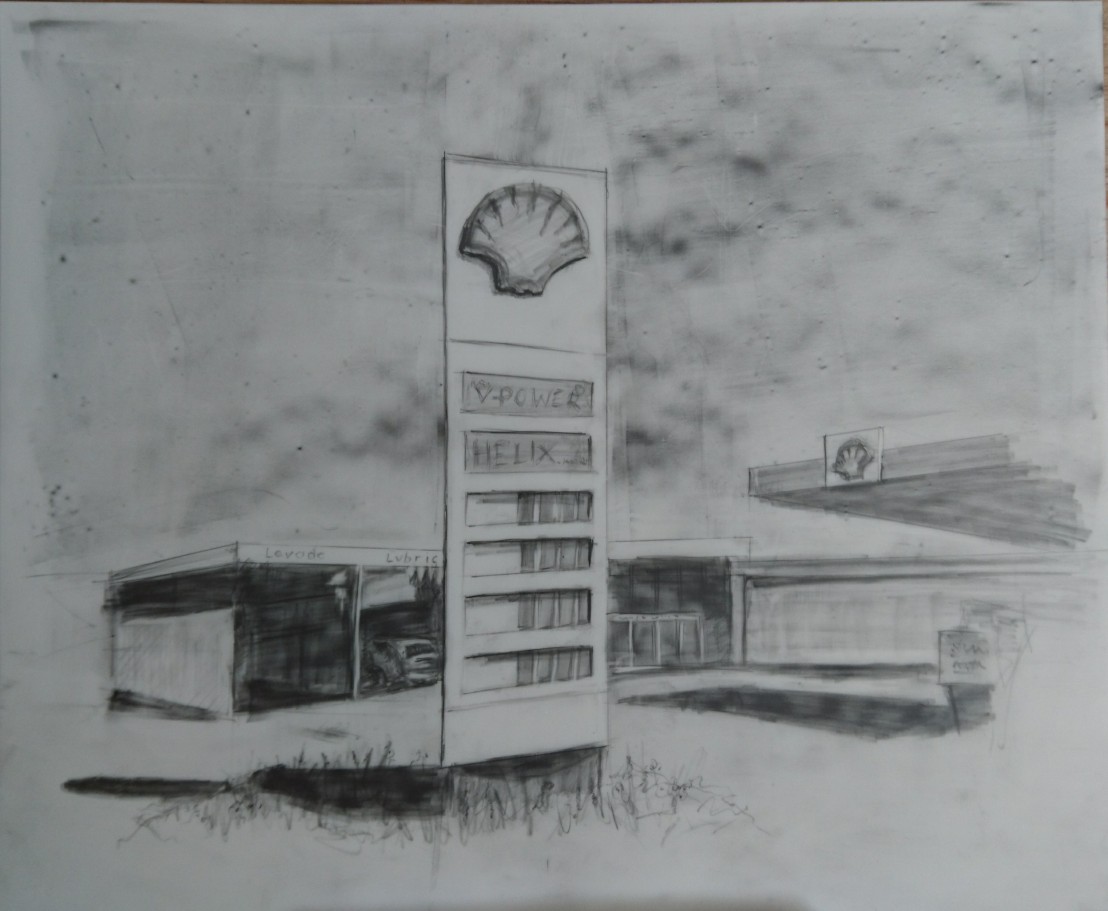
In this drawing there is a feeling of abandonment, the expanse of sky also assists in the eerie feel – no ,ovement, no people, the only sign of life a car – also abandoned. I was not shy in my use of tone and have used a wide range from deep black to erased white. After finishing the drawing I saw that there may have been a better composition!

This crop does not have the same sense of space and abandonment but is a better stronger composition. I should think more about this type of opportunity in future.
Exercise 2 Study of townscape using line
In this exercise I found that I did not have much patience in detailed sketches of buildings. I found myself wanting to rush them except when people were involved – this excites me more – movement, the hustle and bustle of the high street. I took a break for a coffee and sketched in the cafe/mall – this interested me more than the churches outside.

This was a rather hurried sketch – there were problems with scale and perspective which may have led to my impatience in finishing this sketch. This the main church in the town and is placed in an historically famous square – famous for a battle defeat against the spanish just before the independence of Chile. I sketched in the morning on a warm day with strong directional sunlight – the square is difficult to sketch due to many trees placed around and infront of the buildings – which lends itself to cropped details only.

This second sketch using a brush pen and coloured pencil would have been better worked on a larger sheet of paper with charcoal or ink washes.
I went for a coffee and sketched the cafe in an open mall which I enjoyed – there was great potential here and the opportunity to include people and movement:
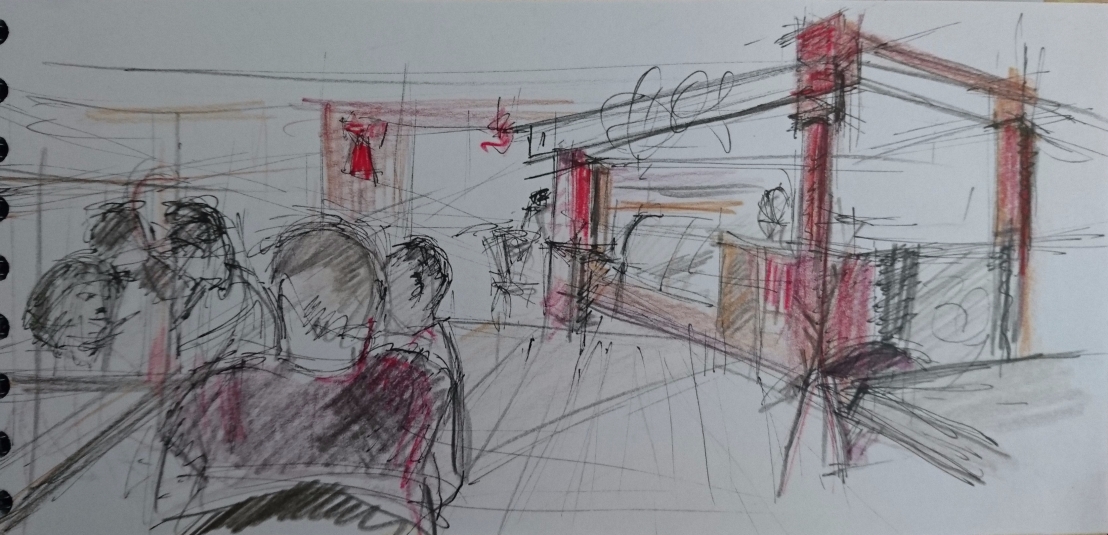
Whilst sketching here I was reminded of the drawings and paintings by Robert Birmelin and his use of transparent overlapping images – For instance his Study – Steps Series, Yellow Shoe 2005. Black chalk, conté pencil, and acrylicwash on 90lb cold pressed Fabriano Classico:
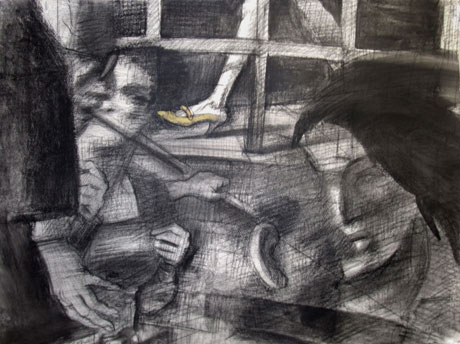
I took several photos to use as reference including this panaramic shot – there is a temptation here to overcomplicate – but the Birmelin example shows that simplification is key in what is really a complex drawing:
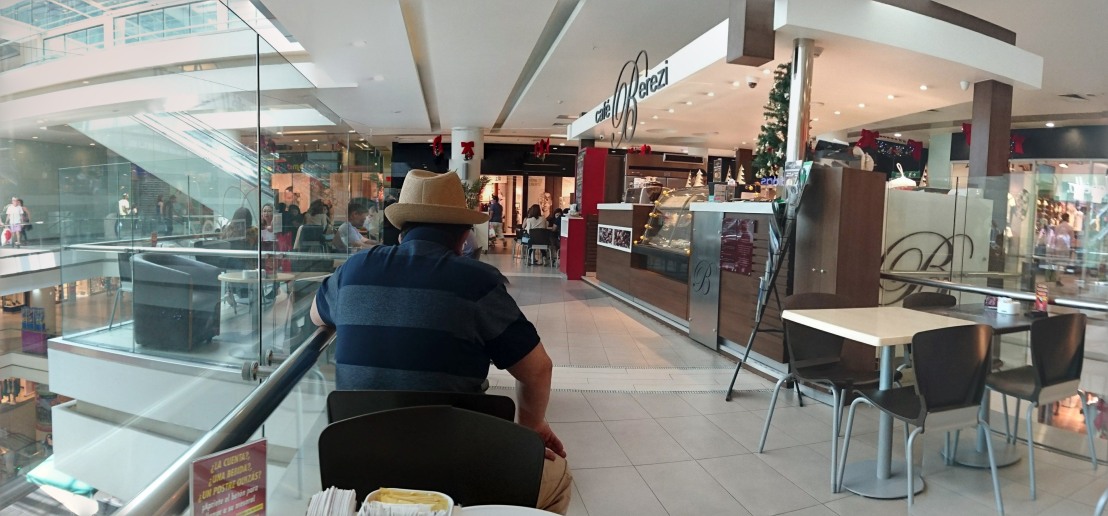
After this coffee break, I went back to the square:
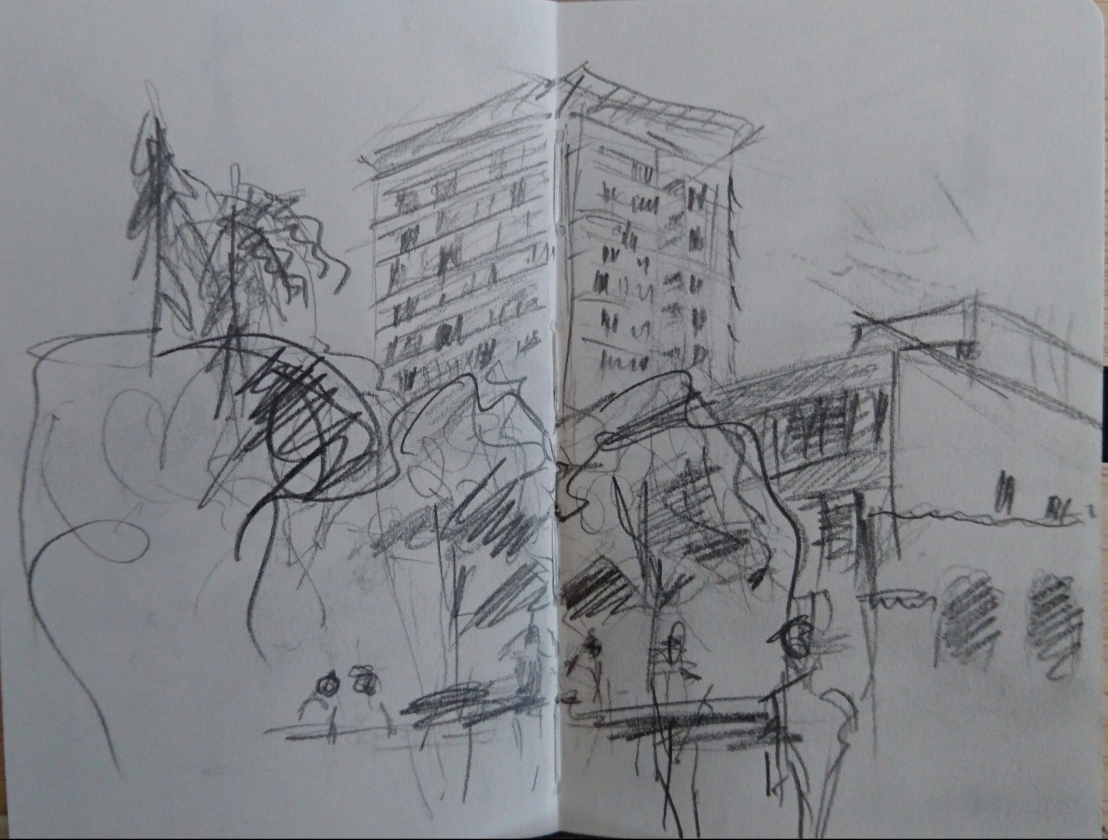
This view also had potential for taking further and I liked the inclusion of people in the foreground, middleground buildings and tower block in the background.
Moving on to the main thoroughfare I enjoyed making rapid gestural sketches of the movement of people and a band playing.


Out of all of these sketches I wanted to take forward the main thoroughfare sketch – an opportunity to include people in an urban environment – I do like the movement of people in drawings/paintings:

The day was hot and the shadows harsh, the main thoroughfare was busy with people rushing about – I love making quick drawings in this type of environment. I should have spent more time drawing, but took several photos that I montaged to get the feel of movement and perspective that I wanted in this final drawing.
Some of the marks I made were erratic and not as balanced as I would have liked – also maybe I should have stuck to just charcoal alone. The drawing was made on A2 but A1 would have suited me better – I did feel a little restricted. The shadows on the left under the tree were poorly made and should have been deeper, the trees were drawn in a manner not reflected in the rest of the image and on this occasion (using line) I felt uncomfortable trying to use just line without some form of tonal contrast. I started the drawing by building up a level of tonal contrast smudging charcoal with my fingers before using line – next time I need to go for greater tonal contrast at this point.
Exercise 3 A limited palette study
Every day I pass the local football stadium in my car early in the morning and on my return from work – I had noted this as an interesting subject. Located in the same street as the abandoned petrol station it has alonside it around 5 very large publicity towers and there a more further up the street – something I that to me seems an invasion on the landscape – a bit like my early protest of the electricity pylons in a field. There is another interest for me in the drawing – on the bottom right – in the traffic light junction. An attraction possibly due to travelling a lot and having had a great deal of changes in my life – crossroads and paths taken (or chosen for me) – like a motif.
The limited palette study was drawn using a mixed media of charcoal and pastel on a heavy mixed media A2 sized paper prepared with a backgound of blue/ochre gouache.
I have started to use my sketchbook more and during the week had taken some photos of the stadium from my car. I made fast sketches of these photos using a 9B pencil whilst thinking of the John Virtue London paintings:
I then went out early in the morning and made two more sketches in my sketchbook – on pages previously prepared with newspaper collage:

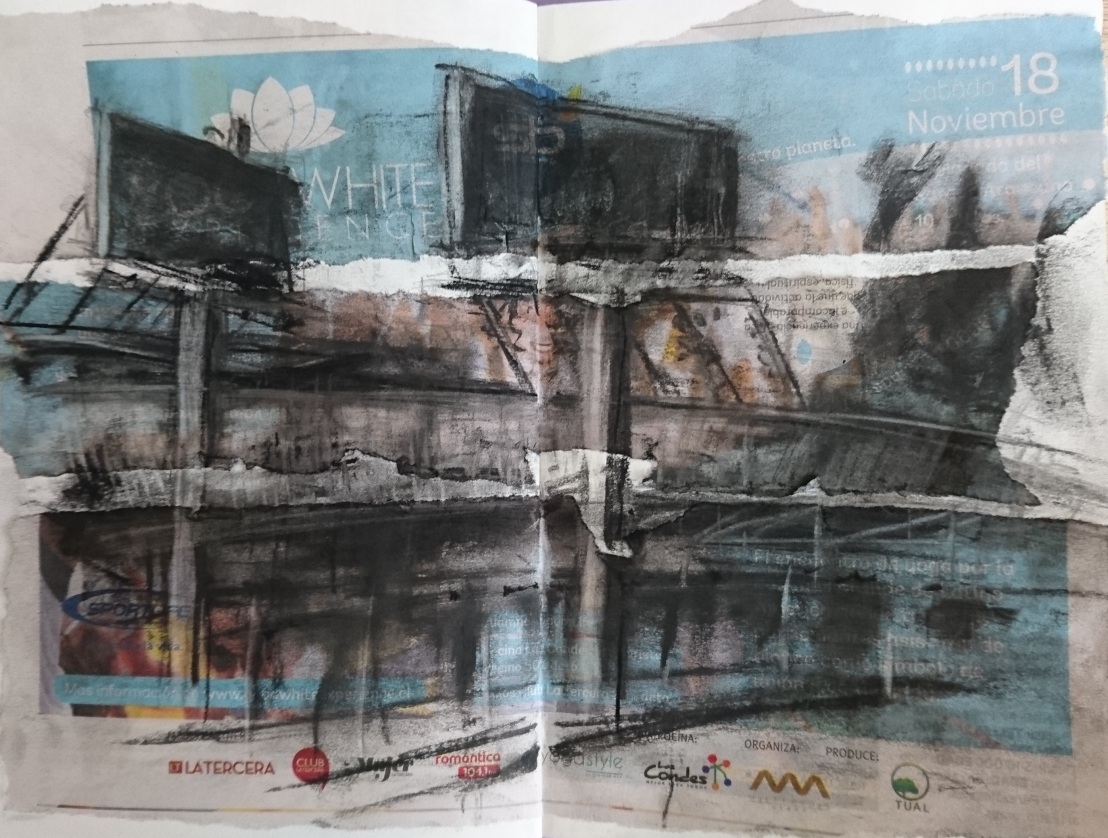
I decided to take these sketches further to use as the subject of my Limited Palette Study:
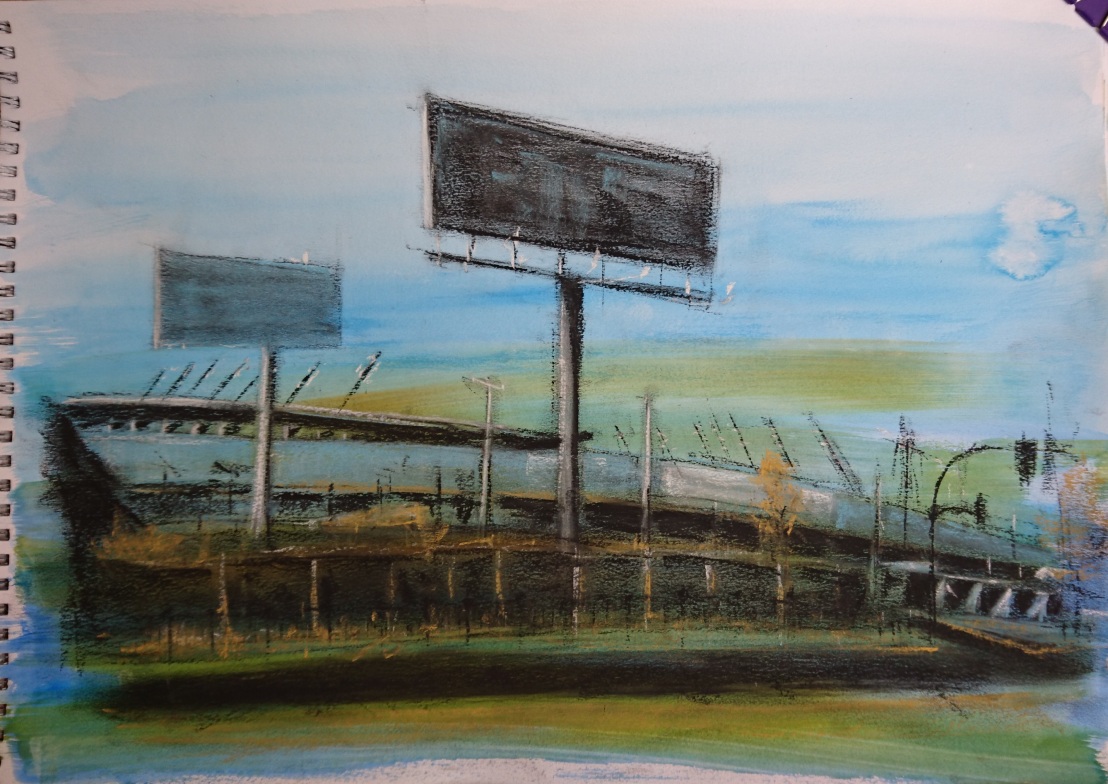
The drawing was completed using blue and ochre pastel with black charcoal, but because I had used a blue/ochre gouche background – I had to include the use of white pastel for highlights.
As a study to create depth using a limited palette – I had given myself too bigger a challenge and did not consider this enough in the choice of subject and the construction of the composition. There were some very complicated angles/curves and I did not consider the lines/angles of perspective as in earlier drawings.
It is possible to use a limited palette to create depth and in hindsight I could have toned down the LHS stadium stand – drawn in dark charcoal – perhaps this could have been a darker blue but without so much detail. Being early in the morning – there was no traffic and nobody in the street – giving the scene an abandoned feeling!
Exercise 4 Statues
During my trip to Bogota, Colombia I was able to sketch some statues – one was the main subject of a quick pen and watercolour sketch I made of Parque Santander:
 I then found a lovely garden square in front of some old buildings – just off of Plaza Bolivar – a statue of Rufino Jose Cuervo. I made two pen and watercolour sketches from different angles:
I then found a lovely garden square in front of some old buildings – just off of Plaza Bolivar – a statue of Rufino Jose Cuervo. I made two pen and watercolour sketches from different angles:
